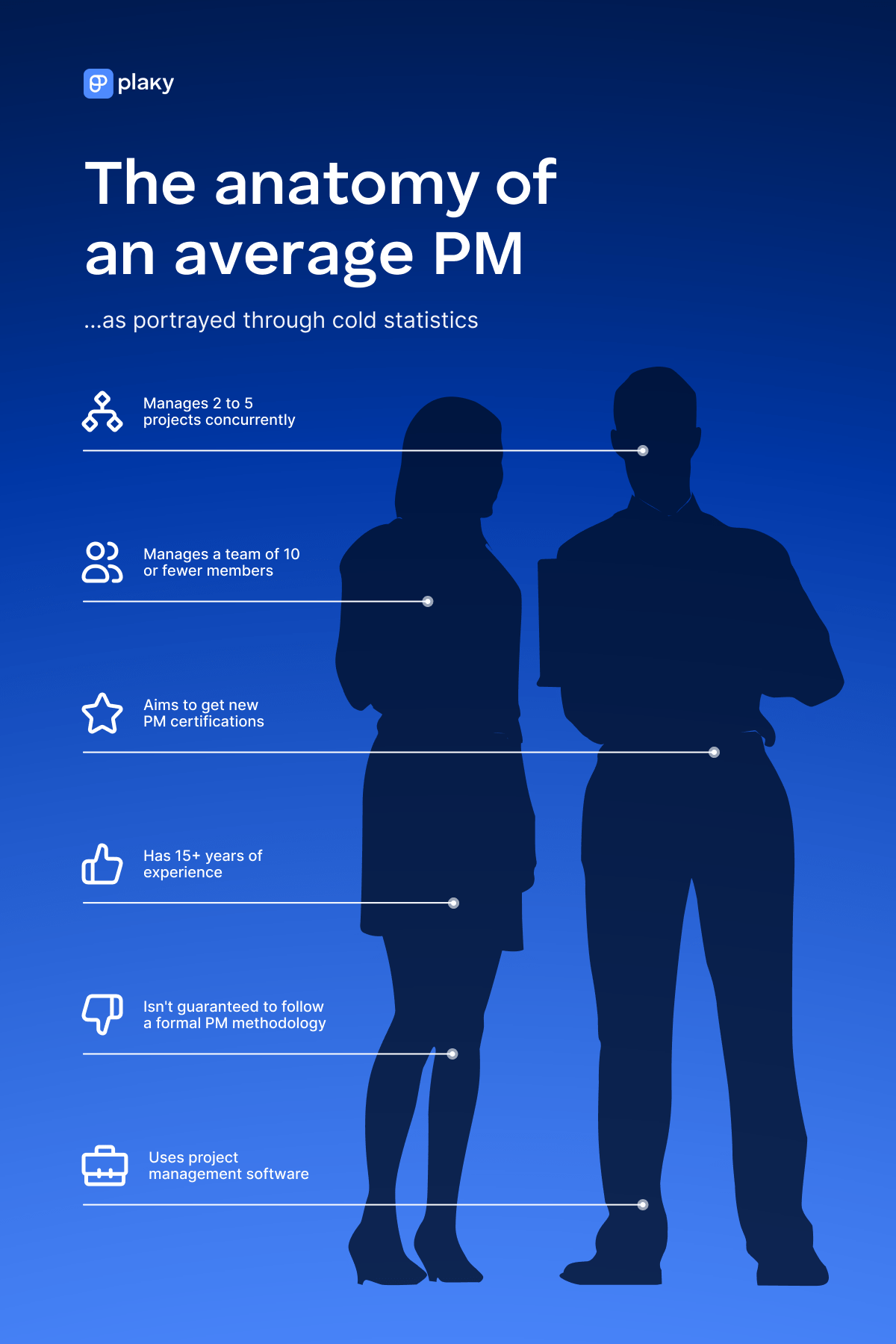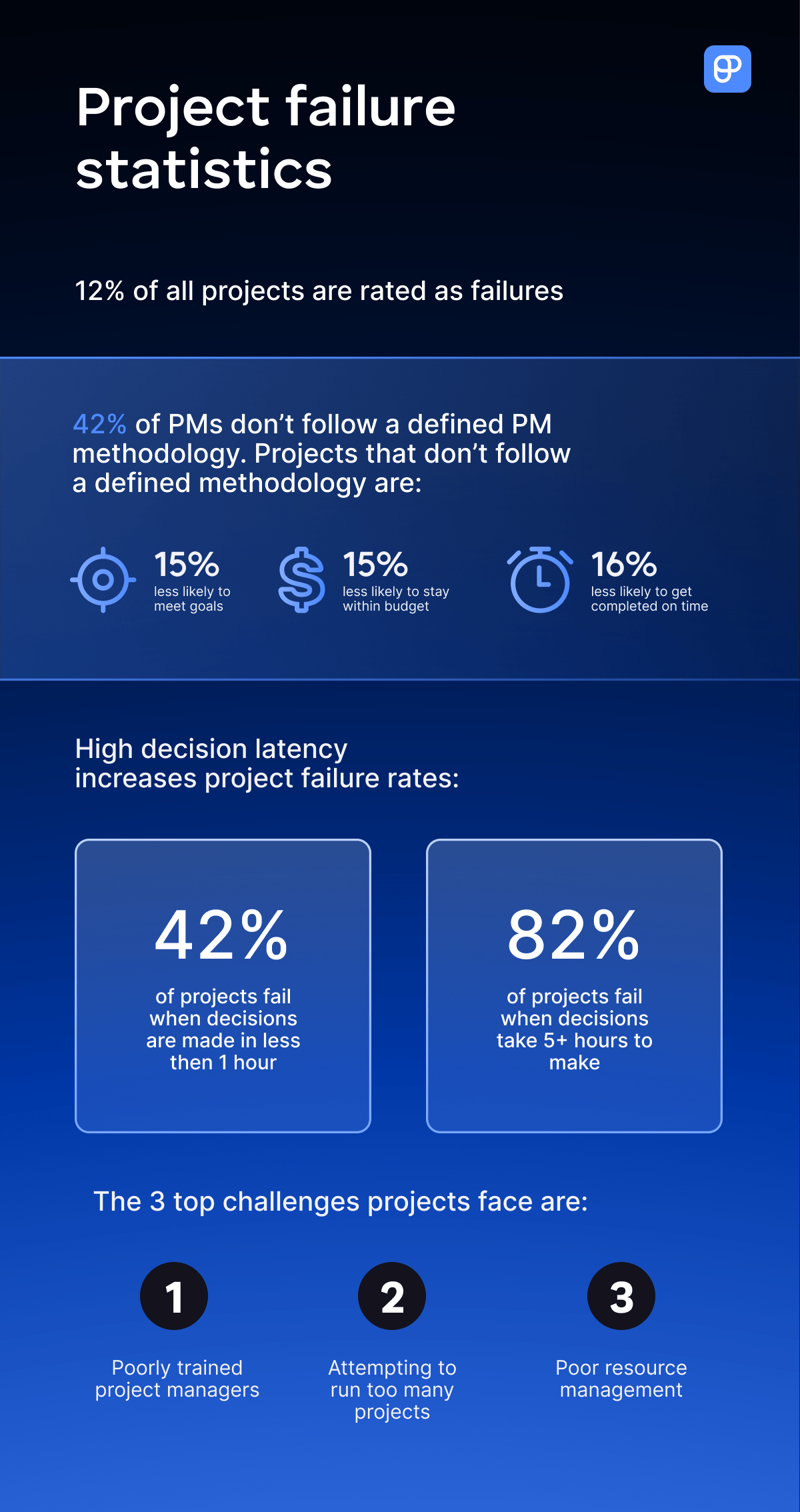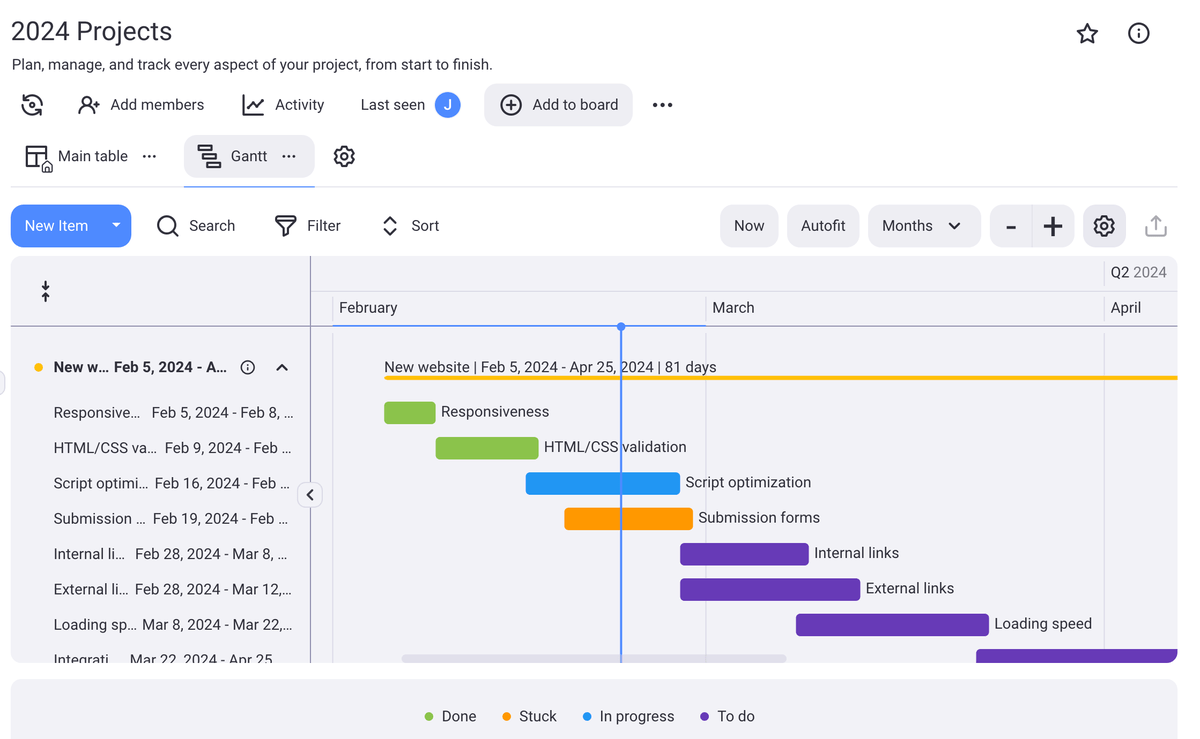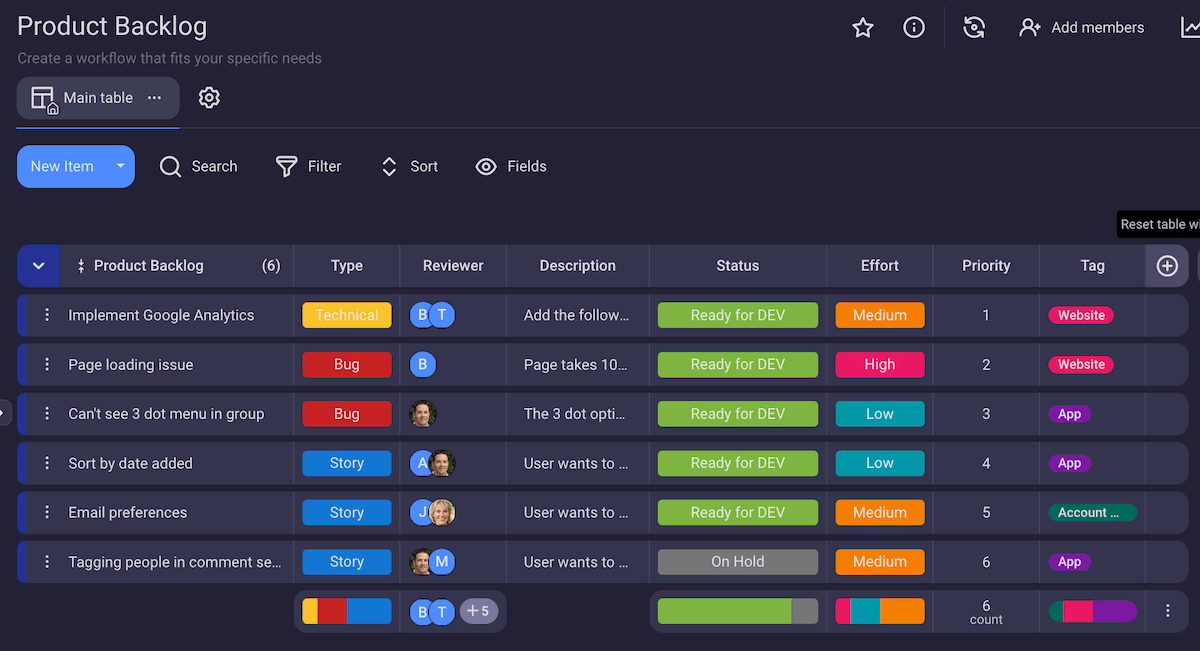You would think that projects are managed by certified project managers, who:
- Follow defined project management methodologies,
- Make sure to use PM software that best fits their workflow, and
- Lead large project teams and manage 1 project at a time.
These were some of the assumptions that I held about project management at large — until I started looking at the statistics. The reality reflected through cold, hard stats, however, paints a different picture.

10 most important project management statistics
To give you a taste of what’s to come, here are some of the most interesting and important statistics you should know about the state of project management in 2025:
- 53% of projects are run by non-certified project managers.
- While the average yearly salary for PMPs has increased by $7,000 in the last 3 years, it has gone down by $3,000 for non-PMP certified project managers.
- The #1 challenge projects face are untrained project managers, followed by the attempt to run too many projects.
- The difference in project success rates of organizations where leadership can make decisions in under 1 hour and those where this takes 5 hours is 40%.
- 42% of PMs don’t follow a defined project management methodology, which makes their projects 15% less likely to meet goals and stay within budget, and 16% less likely to get done on time.
- Fully remote, hybrid, and in-person project teams have almost identical project performance rates (73.2%, 73.4%, and 74.6% respectively).
- 12% of all projects are rated as failures.
- 61% of project workers work remotely at least 1 day a week.
- Organizations that place high priority on soft skills are 8% less likely to lose budget to project failure, 12% less likely to experience scope creep, and 7% more likely to meet business goals.
- 82% of senior leaders plan on using AI in some capacity for project management in the next 5 years.
Statistics on project managers
Project work is on the rise, with 62% of respondents from Wellingtone’s The State of Project Management 2024 report believing that it will only increase. The demand for project managers is so great at the moment that even non-certified PMs have no shortage of work.
That same report also shows that only 47% of projects are run by project management professionals, leaving the remaining 53% to be championed by non-certified PMs.
What’s most striking about this statistic is that it has not budged at all in years. Wellingtone’s The State of Project Management 2021 annual report painted the identical picture — 47% of projects were run by project management professionals back then as well.

PMPs and non-certified PMs aren’t paid the same
- 66% of project managers reported increased compensation in 2023, with 61% of them reporting at least a 5% pay increase. This statistic is derived from the Project Management Salary Survey (13th Edition) conducted by the Project Management Institute, whose respondents were mostly (78%) holders of the Project Management Professional (PMP) project management certification.
- The annualized salary difference between PMPs and non-PMPs in the US is 44%, with PMPs earning an average of $130,000 a year and non-PMPs earning $90,000. This gap has grown over the years, with it being at 32% back in 2021, according to PMI’s Project Management Salary Survey (12th Edition), when PMPs earned $123,000 and non-PMPs earned $93,000 in yearly salary.
- PMPs with less than 5 years of experience make, on average, $112,000 a year in the US. Those with 5 to 10 years of experience make $139,000. PMPs with more than 10 years of experience make $150,000. (Project Management Salary Survey 13th Edition)
PMPs and non-certified PMs have different career goals
- The top 3 career goals for project managers, according to the 2021 Project Management Report by RGPM, include: (1) acquiring a PM certification, (2) getting a new job, and (3) getting promoted.
- 35% of experienced PMs have contemplated leaving the profession. Among less experienced PMs, this percentage increases to 41%. (RGPM 2021)
Most project managers work on multiple projects concurrently
- 59% of PMs manage anywhere between 2 and 5 projects at the same time, according to the 2021 RGPM report.
- Only 15% of PMs manage a single project at a time. (RGPM 2021)
- 15% of PMs manage more than 10 projects at the same time. (RGPM 2021)
Most project teams are small
- 70% of all project teams are composed of 10 or fewer members, according to the 2021 RGPM report.
- 53% of respondents from Wellingtone’s 2024 The State of Project Management report believe that even more work will be carried out by small informal teams in the future.
- Project managers who manage teams of 5 or fewer members earn $106,000 a year, according to the latest PMI salary survey. The salary increases to $120,000 for PMs who lead teams between 5 and 10 people; $125,000 for those leading teams of 10 to 15 people; $130,000 for those leading teams of 15 to 20 people; and $144,000 for PMs who lead teams of 20+.
The demand for project workers is growing, while the average age of project workers keeps increasing
- The number of project-oriented employees is expected to reach 102 million by 2030, according to PMI’s Talent Gap report. The global tally of project-oriented employees in 2019 was 90 million. Accounting for retirement, this projects a demand for 25 million project professionals across the 2020s.
- PMI’s Global Megatrends 2024 report shows that, by the end of the decade, approximately 150 million jobs will shift to 55+ year-old workers. By 2050, 65+ year-olds will outnumber 15 to 24-year-olds.
Women and men in project management
PMI’s The State of Women in Project Management 2023 report shows the following:
- There are 3 times as many men in project management as there are women.
- 20% of female project workers report taking part in management roles, compared to 23% of male project workers.
- Women in project management are more likely to work as full-time employees rather than contractors.
- Women are 3.6% more likely to use Agile approaches and 6.8% less likely to use Waterfall approaches.
- The average salary differential among the sexes in the US amounts to 12%.
- The gender distribution discrepancy among project workers is smallest in healthcare (41% to 59%) and largest in construction (13% to 86%).
AI statistics in project management
- 82% of senior leaders state that AI will play a role in projects at their organization over the next 5 years, according to PMI’s Shaping the Future of Project Management With AI report.
- 21% of respondents from the 2023 PMI Annual Global Survey on Project Management claim to always or often use AI when managing projects.
- 91% of respondents from PMI’s Global Project Management Job Trends 2024 report believe that AI will have at least a moderate impact on the project management profession. To keep up with this, 81% of organizations plan to invest in employee learning and training on the job. At the time of this report, only 14% of employees have been offered AI training, despite 60% of older millennials saying upskilling in AI will be essential.
- The typical cost reduction of AI automating job functions is estimated at 30% in Deloitte’s The Generative AI Dossier.
- Not all industries value AI as highly — KPMG’s 2023 Global Construction Survey shows that only 4% of engineering and construction firms are adopting AI across all projects; 36% are slowly implementing AI in just a few projects; an overwhelming 60% have not adopted AI at all.
- The same survey shows that the potential ROI of artificial intelligence in construction is diminishing, from 17% in 2018 and 16% in 2021 to just 9% in 2023.
Project management remote work statistics
Project management is stepping back from remote work, according to data from PMI’s Pulse of the Profession 2024 report.
- 61% of project workers reported working at least 1 day a week remotely in 2023, as compared to 89% in 2021. Admittedly, some industries were completely shut down at the height of the pandemic lockdowns, so the 2021 data is a bit skewed.
- Only 3% of project managers in construction work fully remotely, while 63% work fully in person (the highest percentage of any industry).
- In healthcare, only 18% of project managers work fully in person, while 35% work fully remotely (the highest percentage of any industry).
- The industry where most project managers work in hybrid locations is finance (64%), followed by telecommunications (51%), government (48%), and IT (48%).
Fully remote, hybrid, and in-person project management are equally effective
The Pulse of the Profession 2024 report shows that the perceived effectiveness of remote work is much lower in the eyes of senior leaders than project managers:
- 33% of project managers feel that remote work is as effective as in-person work.
- Only 25% of senior leaders feel that remote work is as effective as in-person work.
If we look at project performance statistics across the 3 types of work practices (remote, hybrid, and in-person), we see that the differences are marginal:
| Work location | Project performance rate |
|---|---|
| Fully remote | 73.2% |
| Hybrid | 73.4% |
| In-person | 74.6% |
Source: PMI Pulse of the Profession 2024
Agile project management is in decline
Agile used to be the project management buzzword, but statistics from the Pulse of the Profession 2024 report show that Agile projects are on the decline, being supplanted by hybrid approaches.
| Approach popularity in 2020 | Approach popularity in 2023 | |
|---|---|---|
| Predictive | 58% | 43.9% |
| Agile | 23% | 24.6% |
| Hybrid | 20% | 31.5% |
Source: PMI Pulse of the Profession 2024
The definition of hybrid methodologies
If “predictive” and “Agile” are the polar opposite project management approaches, then everything in between them is some shade of “hybrid”.
Consequently, the 2024 Pulse of the Profession report shows that hybrid project management isn’t identical in all companies:
- For 38% of companies, hybrid means mostly predictive with a bit of Agile components.
- For 37% of companies, hybrid means combining Agile and predictive components throughout the whole project.
- For 15% of companies, hybrid means mostly Agile with a bit of predictive components.
- For 8% of companies, hybrid means mostly Agile, but with predictive rollout.
Statistics on project management training and skills
With project management on the rise, it’s only natural that relevant skills are also becoming more desirable.
- According to the 2024 Wellingtone report, 71% of project workers believe people will need more project management skills.
- Despite the overwhelming need for training in project skills, only 45% of respondents from Wellingtone’s 2024 report said that their organization provided accredited training.
- In terms of skill profitability, there has been a 2000% increase in job postings referencing generative AI skills from March to September of 2023. (PMI Job Trends 2024)
Soft skills correlate with key drivers of project success
According to the PMI’s Pulse of the Profession 2023 report, the key drivers of project success are:
- High benefits realization management (BRM) maturity,
- Low levels of scope creep,
- Frequent use of standardized risk management practices,
- Frequent use of standardized stakeholder engagement practices,
- High organizational agility,
- High performance of department-specific/regional/divisional project management office (PMO),
- High project management maturity,
- Overall performance of enterprise-wide PMO,
- Quality of work, and
- Adherence to schedule.
Organizations that place a high priority on soft skills report higher key drivers of project success:
| Organizations that place high priority on soft skills | Organizations that place low priority on soft skills | |
|---|---|---|
| Report high BRM maturity | 57% | 18% |
| Report high project management maturity | 64% | 32% |
| Report high organizational agility | 51% | 16% |
| Meet business goals | 72% | 65% |
| Experience scope creep | 28% | 40% |
| Lose budget to project failure | 17% | 25% |
Source: PMI, Pulse of the Profession 2023
How PM processes rank on value and difficulty
In Wellingtone’s 2024 report, respondents were asked to rank which project management processes — assuming they are undertaken properly — provide the most value and which are the most difficult to embed.
According to their results, the highest-value, low-difficulty processes are:
- Stakeholder engagement,
- Risk management, and
- Planning.
Low-value, low-difficulty processes include:
- Project sponsorship,
- Project status reporting,
- Lifecycle governance,
- Cost management,
- Progress management,
- Document management, and
- Portfolio reporting.
Processes that ranked as highly difficult yet low-value include:
- Change control,
- Benefits realization,
- Resource management,
- Lessons learned, and
- Project prioritization.
There were no processes that ranked as both high-value and high-difficulty.
Statistics on Project Management Offices (PMOs)
According to Wellingtone’s 2024 report, the top 5 activities performed by most PMOs are:
- Project status reporting,
- Maintaining the project list/portfolio,
- Maintaining the PM methodology and document templates,
- Facilitating project approval process, and
- Project assurance.
The 3 PMO activities that have increased the most in the 5 years prior include:
- Project assurance,
- Ownership of an enterprise PPM solution, and
- Cross-project dependency management.
PMOs are settling down
Since the beginning of the decade, PMOs have started becoming more common, while also settling down in terms of employee numbers. Looking at the 2024 Wellingtone report, we can see that:
- 82% of organizations have 1 or more PMOs. On top of that, roughly 1 in every 4 PMOs had been opened in the 2 years prior to the release of this report.
- 38% of PMOs plan to increase in size during the next year, compared to 57% from the year prior.
- At the same time, 57% of PMOs plan to increase in scope and responsibilities. Again, this represents a sizable downgrade compared to the previous year’s 72%.
- Even the perceived value of PMOs is shrinking, with only 54% of PMOs increasing in perceived value compared to the 71% from the year prior.
PMO performance and distribution across different sectors
According to PMI’s Built to Thrive: PMOs That Elevate Innovation and Power Transformation report, PMOs have the most presence in these sectors:
| Sector | Proportion of organizations in each sector that have some form of PMO |
|---|---|
| Financial services | 89% |
| Aerospace | 82% |
| Telecom | 80% |
| Energy | 76% |
| Consulting | 73% |
| Pharmaceutical | 73% |
Source: PMI’s Built to Thrive report
The only 2 industries that have a PMO presence lower than 50% are mining (48%) and construction (47%).
Meanwhile, the most high-performing PMOs are found within the consulting sector, with a whopping 74% of respondents from this report rating their organization’s PMOs as high-performing. This is followed by the energy and information technology sectors at 61% and 56% respectively.
How PMO performance correlates with the use of technologies
According to PMI’s Built to Thrive report, there’s a striking correlation between high-performing PMOs and the ability to leverage different technologies for managing project work.
Specifically, companies with high-performing PMOs are:
- 7% more likely to use document management software,
- 6% more likely to use collaboration software,
- 7% more likely to use budgeting and financial tools,
- 13% more likely to use project management software,
- 20% more likely to use analytics and reporting tools,
- 12% more likely to use enterprise resource planning software,
- 15% more likely to use portfolio management software,
- 16% more likely to use product development software, and
- 10% more likely to use low-code/no-code platforms.
The benefits of high-performing PMOs
PMI’s Built to Thrive report on PMOs also highlights the biggest benefits organizations reap from having high-performing PMOs, such as the improved:
- Ability to deliver value to customers (80% compared to 51% of non-high-performing PMOs),
- Ability to quickly reprioritize (47% compared to 36%),
- Ability to empower people/teams (73% compared to just 31%),
- Ability to learn and share knowledge (72% vs just 30%),
- Commitment to continuous improvement (71% compared to only 23%), and
- Ability to clearly communicate strategy (67% compared to 25%).
Project management failure statistics
According to PMI’s Maximizing Project Success report, 12% of all projects are rated as failures, while 40% are seen as having produced mixed results. Naturally, this means 48% are successes, but more on that in the next section.
According to Wellingtone’s The State of Project Management 2024 report, the top 10 challenges projects face include:
- Poorly trained project managers,
- Attempting to run too many projects,
- Poor resource management,
- Inconsistency in approach,
- A lack of project funding,
- Frequent changes to scope,
- Doing the wrong projects (lack of strategic alignment),
- Ineffective implementation of PPM solutions,
- Poorly trained project sponsors, and
- Lack of appropriate software.

Decision latency affects project failure rates
- The success rate of projects where leadership can make decisions in less than 1 hour is 58%, according to ScrumInc’s study that links project failure and decision lag.
- The same study shows that when leadership drags out the decision-making process to 5 hours, the project success rate plummets to just 18%.
Industries with the highest percentage of failures
According to PMI’s Maximizing Project Success report, the following industries have the highest percentage of project failures:
- Government sector (21%),
- Consulting (20%),
- Energy and utilities (14%),
- Communication services (13%), and
- Consumer discretionary and staples (13%).
Many PMs don’t follow formal methodologies
42% of PMs don’t follow a defined project management methodology, according to the 2024 report by Wellingtone. This figure is identical to the one highlighted in their 2021 report, which further showed that projects without a formal methodology have significantly lower project success rates.
| Projects with formal PM methodologies | Projects without formal PM methodologies | |
|---|---|---|
| Met goals/intent | 73% | 58% |
| Completed within budget | 63% | 48% |
| Completed on time | 59% | 43% |
Source: Wellingtone, The State of Project Management 2021
Who decides what counts as a failure?
PMI’s Maximizing Project Success report shows that project participants and stakeholders rate projects that fail to deliver on key benefits — such as sustainability or social impact — significantly higher than the intended beneficiaries of those projects.
With this in mind, it’s safe to say that the global project failure statistic of 12% would likely be much higher if projects were judged by their customers, rather than the people working on them.
Project management success statistics
Globally, 48% of projects are seen as successes, according to PMI’s Maximizing Project Success report.
However, it’s worth delving into what exactly it means for a project to be considered a success.
The 3 criteria used to measure project success are whether it:
- Was delivered on time,
- Was delivered on budget, and/or
- Has delivered a useful/valuable outcome (scope).
According to Wellingtone’s 2024 report, global project performance with regard to these criteria looks like this:
- 34% of organizations mostly or always complete projects on time,
- 34% of organizations mostly or always complete projects on budget, and
- 36% of organizations mostly or always deliver the full benefits of their project.
However, many successful projects meet only 2, or even just 1, of these criteria.
In PMI’s Maximizing Project Success report, respondents were asked to rate their projects between 0 and 10. The results of this survey show us that projects that deliver on scope (a valuable/useful outcome) are more likely to be perceived as successes than those that hit the mark regarding time and budget, but not scope:
| Criteria | Rates of perceived success |
|---|---|
| Delivered on time and on budget, as well as a valuable/useful outcome | 74% |
| Delivered a valuable/useful outcome | 69% |
| Delivered on time and on budget | 64% |
Source: PMI’s Maximizing Project Success report
Top predictors of success
According to PMI’s Maximizing Project Success, the following 5 performance levers have the highest correlation with project success:
- Having a well-established performance measurement system,
- Caring for team morale,
- Adequate funding to completion,
- Effective resource management, and
- Minimum start-up difficulties.
This report also looked at performance themes, i.e., criteria that projects had delivered or were on track to deliver. The 5 performance themes that correlated most highly with project success included:
- Sustainability and social impact,
- Level of quality,
- Met defined requirements,
- Customer satisfaction, and
- Employee experience.
Additionally, projects aligned with social impacts are more likely (55%) to deliver on customer satisfaction than those that don’t take this into consideration (33%).
Project management software statistics
- 39% of users cite the lack of a specific functionality as the leading cause of their dissatisfaction with certain software, according to Capterra’s Project Management Software Market Research Report.
- The 3 most important factors in choosing PM software are (in order): functionality, price, and ease of use. (Capterra)
- Only 10% of users demo 4 or more products to guarantee the software they purchase will have everything they need; 46% of users demo 2 products; 31% of users demo 3 products; 13% of users demo only 1 product. (Capterra)
- 71% of project workers believe that the use of team collaboration tools will increase, according to Wellingtone’s 2024 report.
- 47% of project workers say they are unable to track project KPIs in real time. (Wellingtone 2024)
- 50% of project workers waste at least 1 day each month manually sifting through data and compiling reports. (Wellingtone 2024)

Project management software feature usage breakdown
The following tables depict which features users:
- Have access to and use,
- Have access to yet don’t use, and
- Would use if they had access to.
Surprisingly, the second and third tables have a lot of overlapping features, indicating that one man’s trash feature is another man’s treasure feature.
| Feature | Used by % of users who have access to it |
|---|---|
| Reports/dashboards | 65% |
| Document management | 64% |
| Collaboration | 60% |
| Requirements management | 57% |
| Budgeting | 55% |
| Resource planning | 54% |
| Time tracking | 53% |
Source: Capterra, Project Management Software Market Research Report
| Feature | Not used by % of users who have access to it |
|---|---|
| Velocity charts | 34% |
| Gantt charts | 34% |
| Burndown charts | 34% |
| Risk management | 32% |
| Kanban boards | 30% |
| Project request intake form | 29% |
| Product roadmapping | 28% |
Source: Capterra, Project Management Software Market Research Report
| Feature | % of users who want the feature but don’t have it |
|---|---|
| Gantt charts | 22% |
| Burndown charts | 21% |
| Automated workflows | 20% |
| Velocity charts | 20% |
| Portfolio management | 19% |
| Product roadmapping | 19% |
| Project request intake form | 19% |
Source: Capterra, Project Management Software Market Research Report
Improve project success rates with Plaky
While statistics make for fun trivia, they can also help point you in the right direction.
For example, the 3 most important factors when choosing PM software are:
- Functionality,
- Price, and
- Ease of use.
To steer your projects toward success, you should go for project management software that checks all 3 of these boxes — like Plaky does!
Functionality
Plaky offers ample:
- Task management features (status tracking, activity logs, sorting and filtering),
- Administration features (roles and permissions),
- Team collaboration and communication features (comments and notifications), and
- Views (table, Kanban, and Gantt views).
This means that every team will have access to all the features they need and that they will be able to customize how that information gets displayed to optimally suit their workflow.

Price
All essential project management features (which most other apps lock behind paywalls) are available for free on Plaky, including unlimited members and unlimited tasks. Advanced features, like the ever-divisive Gantt charts, are unlocked through Plaky’s approachably priced paid plans that start at a monthly price of just $3.99 per user.
Pound for pound, no tool can compete with Plaky in terms of sheer value.
For a detailed breakdown of what each plan offers, check out Plaky’s pricing page.

Ease of use
Plaky is an intuitive and easy-to-use PM tool that has a shallow learning curve. While it’s completely customizable, it also offers plenty of free project management templates that teams can use to get their boards started immediately.
This makes Plaky a great pick even for project teams who aren’t tech-savvy. No need to spend hours setting up your custom workflow — just load up a template and start managing projects. If the templates are slightly off, you can always tweak them to better suit your workflow.

Ready to contribute to the rise of success statistics? Give Plaky a try today!
How we reviewed this post: Our writers & editors monitor the posts and update them when new information becomes available, to keep them fresh and relevant.

